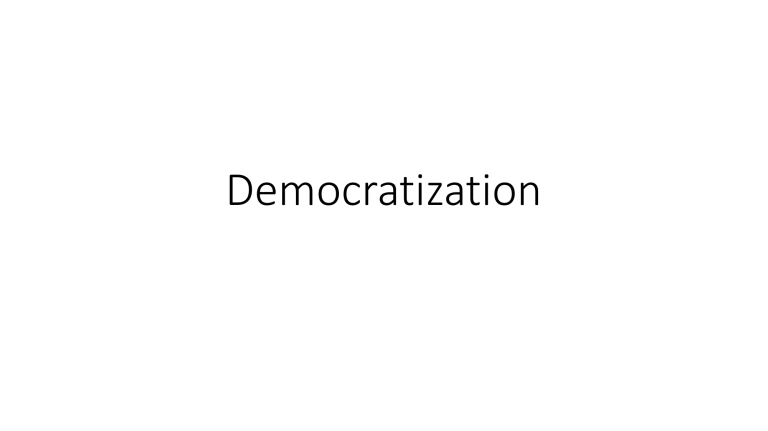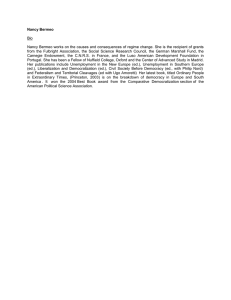
Democratization Lipset, 1959 • What is Democracy? • For Europe/U.S. • For S. America - • What Correlates w/ Democratization? • Increased Wealth, Urbanization, Literacy, and Industrialization • What are the proposed mechanisms? • Social Mobilization • Emergence of bourgeoise Boix, 2003 • What is Democracy? • (1) Free multiparty elections; (2) Executive is elected by the population and is responsible to them; (3) at least 50% of adult men can vote (p. 66). • What Correlates w/ Democractization? • High Capital Mobility • High Economic Equality • What are the Proposed Mechanisms? • Democratization occurs when democracy becomes cheaper than authoritarianism and leaders are no longer motivated to block the redistribution of wealth via democracy. Acemoglu and Robinson, 2006 • What is Democracy? • “A country is a democratic if a certain political process takes place – if certain key institutions, such as free and fair elections and free entry into politics, are in place” (p. 17-18). • What Correlates w/ Democratization? • Democracy occurs when civil society is mobilized, when economic/political crises occur, when elites are industrialists, when institutions are built to limit damage to elites, when a middle level of inequality is present, when a middle class is present and when trade integration has occurred. • What are the Proposed Mechanisms? • Democratization occurs when elites are unwilling to oppose it because their place in society is not threatened Linz and Stepan, 1996 • What does a consolidated Democracy look like? • Linz and Stepan define what a consolidated democracy looks like behaviorally, attitudinally, and constitutionally (p. 6). Essentially, democracy is consolidated when it becomes “the only game in town.” • They identify 5 major arenas that exist in a consolidated democracy (summarized in a table on p.14): • • • • • civil society political society rule of law state apparatus economic society Caraway, 2004 • Who counts in studies of democratization? And who is left out? • Many studies only incorporate white male suffrage in their analysis of democratization. Inclusion of women and racial minorities are often ignored outside of “outlier” cases. • Why is this a problem? • “Any move to include an excluded group is a form of democratization” (p.454) • “Such a simplistic view overlooks the extent to which class, gender, and race are mutually constructed and interact in concrete historical circumstances.” (p.457) Paxton, 2000 • Who counts in studies of democratization? • Most conceptual definitions of democracy include women while many operationalized definitions exclude them. • Why is this a problem? • Including women changes the dates of democratic transitions. This changes “our perception of the emergence of democracy” (p.105). • What can be done to fix this gap? • Paxton recommends the development of graded measures instead of dichotomous measures when researching democratization and democracy. Morgenbesser, 2018 • Why does authoritarian regime type matter for democratization? • Scholars have argued that certain types of regimes are more likely to democratize than others. • Understanding authoritarian regimes and tracking their transitions is the goal of many projects, such as the polity project and varieties of democracy • How can we prevent misclassification of regimes? • Misclassification can be reduced by utilizing area/state experts. Discussion Questions • Caraway notes that more recent democratizers did not limit suffrage based on race, but some countries have limited citizenship based on race (Japan). Is limiting citizenship a way of limiting suffrage? • Will transitions to democracy be explained by the same factors today as they were in the past? • Does democratic political culture precede the consolidation of democracy or is it a result of democratic consolidation? • Is democracy better understood as a result of the proper combination of structural and/or institutional features, or is it a byproduct of agents acting to produce democracy?


